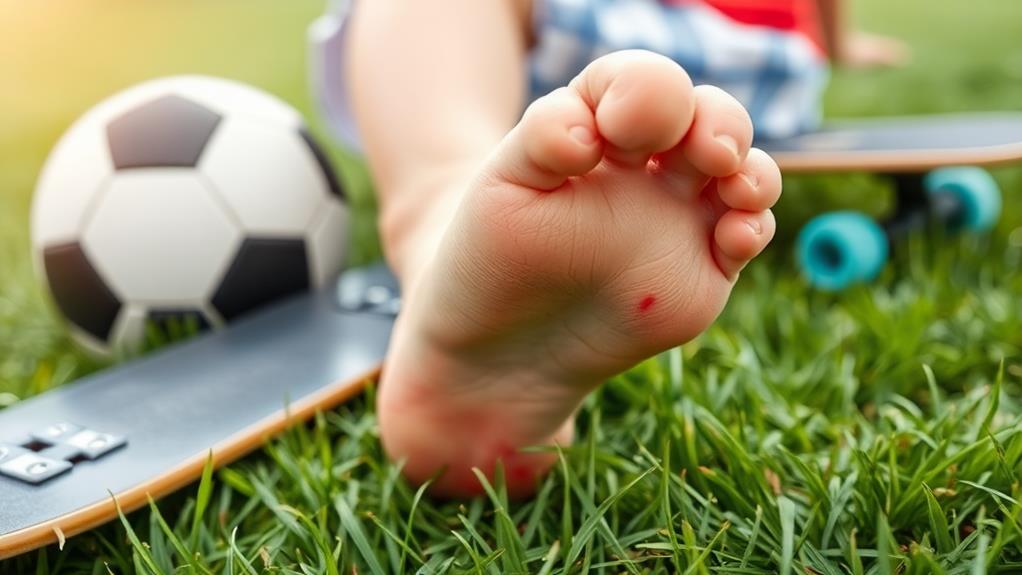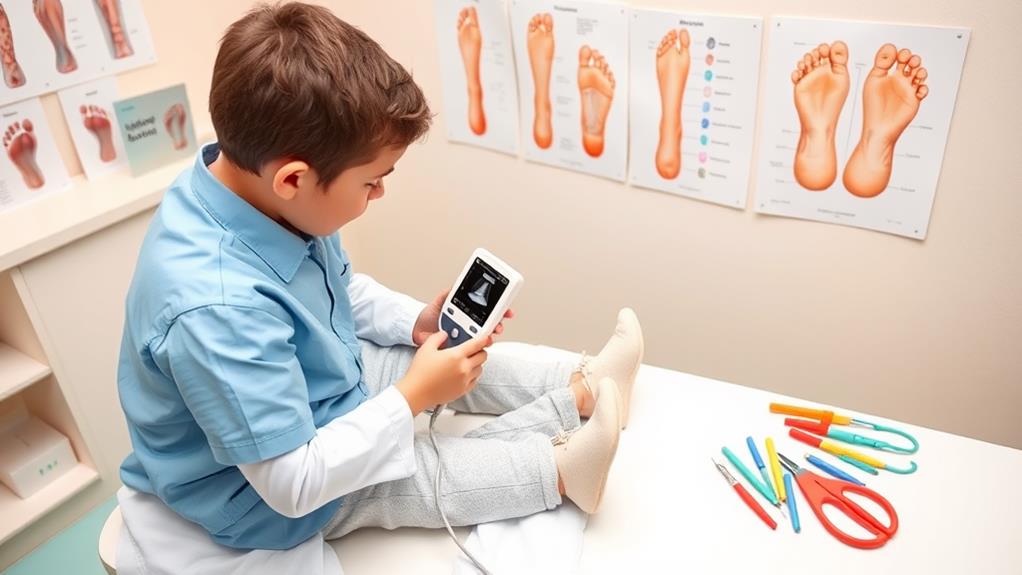If you've noticed your child complaining about heel pain, you're not alone. Many kids face this issue, often linked to common conditions like Sever's disease or improper footwear. You might be surprised to learn how everyday activities and sudden increases in physical exertion can contribute. Ignoring these signs could lead to more serious problems down the line. Understanding the symptoms and underlying causes is essential, but what exactly should you look for to ensure your child gets the right care?
Common Causes of Heel Pain

When your child complains about heel pain, it can be concerning, especially since several factors might be at play. One common cause is a condition called Sever's disease, which often affects active kids. It occurs when the growth plate in the heel becomes irritated, usually due to overuse during sports or play. Kids who run, jump, or engage in high-impact activities are particularly susceptible.
Another possible reason for heel pain is plantar fasciitis. This happens when the tissue connecting the heel bone to the toes becomes inflamed, leading to discomfort. Overweight children may be at a higher risk, as excess weight can put extra strain on their feet.
Improper footwear can also contribute to heel pain. Shoes that lack support or cushioning can cause discomfort and lead to injuries. If your child has flat feet or high arches, this may further complicate things, as certain foot structures can predispose them to pain.
Lastly, a sudden increase in activity level can lead to soreness. It's essential to monitor your child's activities and encourage proper warm-up routines to help prevent injuries.
Recognizing these common causes can assist you in seeking the right treatment for your child.
Symptoms to Watch For
If your child is experiencing heel pain, it's crucial to watch for specific symptoms that could indicate a more serious issue. Pay attention if the pain is severe, especially when your child is walking or running.
If they start limping or avoiding putting weight on their heel, it's a sign that something might be wrong. Swelling or redness around the heel is another symptom to note; this could mean inflammation or an injury.
You should also keep an eye out for any changes in their behavior. If your child becomes more irritable or less active than usual, it might be due to discomfort.
Additionally, if the heel pain persists for more than a few days without improvement, it's time to take action.
Look for any signs of fever or other unusual symptoms, as these could indicate an infection or other medical conditions.
Diagnosis and Evaluation

After noticing the symptoms of heel pain in your child, it's important to seek a proper diagnosis and evaluation. Start by scheduling an appointment with your pediatrician or a specialist, like a pediatric orthopedic doctor.
They'll ask about the pain's location, when it started, and any activities that may have contributed to it. This conversation helps them understand your child's specific situation.
Next, the doctor might perform a physical examination, checking for swelling, tenderness, or any issues with your child's gait.
They may also ask your child to walk or run to observe how they move. In some cases, imaging tests like X-rays or MRIs may be necessary to rule out any underlying conditions, such as fractures or growth plate issues.
Treatment Options Available
Treatment for heel pain in kids typically focuses on relieving symptoms and addressing the underlying cause.
First, your doctor might recommend rest to give those sore heels a break. Reducing physical activity, especially high-impact sports, can help alleviate pain. Ice packs applied to the heel can also provide relief, so consider using them after activities.
Stretching exercises are another great option. Simple calf and Achilles tendon stretches can improve flexibility and reduce tension.
If your child's heel pain persists, your doctor might suggest over-the-counter pain relievers like ibuprofen or acetaminophen to help manage discomfort.
In some cases, supportive footwear or orthotic inserts can make a big difference. These can help with alignment and cushioning, providing extra comfort during walks or runs.
Physical therapy may also be beneficial, as a trained therapist can guide your child through exercises tailored to strengthen the foot and ankle.
For severe or ongoing issues, your doctor may discuss more advanced treatments.
Importance of Early Intervention

Recognizing heel pain early can make all the difference in your child's recovery. If you notice your child limping, complaining about their heels, or avoiding activities they usually love, don't ignore it. Early intervention is crucial because it can prevent minor issues from becoming serious problems.
When you address heel pain right away, you give your child the best chance to heal quickly and return to their regular activities. Ignoring heel pain can lead to chronic discomfort or even long-term damage. By seeking help from a healthcare professional promptly, you can identify the underlying cause, whether it's a growth-related issue or an injury. This way, you can explore the right treatment options tailored to your child's needs.
Additionally, early intervention can help reduce your child's anxiety about their pain. When they understand what's happening and see that relief is on the way, it can make a world of difference in their emotional wellbeing.
